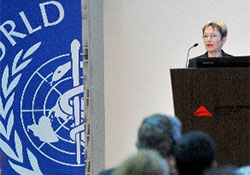Policy debate continues in Slovenia, where every 10th person practices hazardous drinking

Ministry of Health, Slovenia
Overall alcohol consumption is slowly declining in the WHO European Region, but large differences are evident between and within countries. Slovenia belongs to the group of countries with high alcohol-attributable standardized mortality (50-69.9 per 100 000 people), including alcohol-attributable liver cirrhosis, cancer and injury deaths. Every tenth adult aged 25-64 drinks alcohol hazardously and has an increased probability of facing social, health and other consequences of alcohol consumption.
The National Institute of Public Health (NIPH) in collaboration with the Ministry of Health and WHO organized the third national conference on alcohol policy in Ljubljana, on 14-15 January 2015, to highlight the need for appropriate policies to reduce the burden of hazardous and harmful alcohol consumption in Slovenia.
Cost-effective alcohol policies can address the general public and reduce total alcohol consumption through taxation, limiting availability and marketing; and address those at risk or high alcohol consumers through screening, brief intervention and treatment options. Implementing a broad range of alcohol policies at national level will make it possible to achieve WHO’s global target of reducing harmful alcohol use by 10% by 2025.
More than 200 participants received a policy brief, “Alcohol policy in Slovenia – opportunities to reduce the damage and costs,” which was drafted to equip decision-makers with credible information and evidence on the extent of the alcohol problem in Slovenia and to introduce proven-effective alcohol policy measures.



